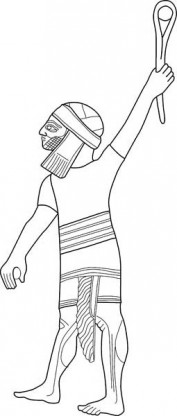

One of the most colorful stories in the Bible relates how Ehud, the left-handed Israelite judge from the tribe of Benjamin, freed Israel from Moabite domination (Judges 3:12–30). When Ehud delivered Israel’s annual tribute to the Moabites, he assassinated the fat Moabite king by using a double-edged dagger he had hidden on his right thigh. The story is famous for its gory detail (“the fat closed over the blade … and the dung came out … ‘Surely he is relieving himself’ ”) but also for its hero who succeeds, in part, because he is left-handed.1
This mention of left-handed Ehud is one of only three places in the Bible involving left-handed people. All of these left-handers appear in military contexts,2 and all, curiously, come from the tribe of Benjamin. In addition to the left-handed Benjamite Ehud, Judges 20:16 refers to 700 Benjamites who could use the sling with great accuracy (“Every one could sling a stone at a hair and not miss”; see illustration), and all were left-handed. Finally, 1 Chronicles 12:2 states that some of the Israelites who came to support David when he ruled in Hebron included some two dozen ambidextrous warriors who could use either the bow or the sling “with either the right or the left hand; they were Benjamites.”

This consistent intersection of left-handedness and the tribe of Benjamin raises a question: Did this one particular tribe produce an unusually high number of left-handers? If so, why? Could it have been because of some genetic or social factor, or perhaps both? Might modern genetic studies give us some insight into this curious case of the left-handed Benjamites? Perhaps it can.
The factors that influence handedness have been studied for years,3 although there is still no clear understanding of all the determinants. Current research suggests that handedness is influenced by a complex interplay of both environmental and genetic factors. Studies of twins suggest that genetic effects account for 25 percent of the variation of handedness, and unique environmental influences account for the remainder.5 Some proposed environmental effects on handedness are societal, such as modeling handedness, forced handedness and stigmatization.6
Other studies based on prenatal ultrasounds show that handedness formation occurs prenatally, before societal influences on handedness are present.7 Familial aggregation of handedness is also consistent with a genetic component: In one study, it was found that two left-handed parents have a 26 percent chance of having a left-handed child, while the prevalence is 20 percent with one left-handed and one right-handed parent, and 10 percent with two right-handed parents.8 Most recently, genetic mapping studies provide support for a genetic basis of handedness. Several genes and chromosomal locations are associated with being left-handed.9 It appears that there is a genetic component to handedness, but it is a very complex interaction between multiple genes that is influenced heavily by environmental factors.
Thus, it seems quite possible that the tribe of Benjamin produced more left-handed people than did other Israelite tribes. Perhaps they were genetically inclined to left-handedness, and the tribe may also have encouraged it. The Hebrew term for “left-handed” in Judges 3:15 and 20:16 literally means “restricted (’iṭṭēr) in his right hand.” Did the Benjamites bind the right arms of their sons to their sides to encourage use of the left hand?10 The phrase “restricted in his right hand” seems to allow for the possibility, although it may just as easily mean something like “can’t use his right hand like normal.”
Some authors suggest that Benjamites and others may have encouraged left-handedness because it would be advantageous in combat.11 Since soldiers would be less apt to confront a left-hander (as with Ehud), left-handed warriors may well have had an advantage in fighting hand-to-hand. In addition, ancient city gates were often built with a right-hand turn in order further to expose right-handed attackers, suggesting another possible benefit for left-handed troops.
However, the idea that left-handedness was militarily advantageous loses some of its force since the references to units of left-handed Benjamites describe slingers and archers (Judges 20:16; 1 Chronicles 12:2). Such troops used long-distance weapons, where the advantage of using the less common hand is difficult to see.
So did the tribe of Benjamin produce more left-handers, as the three Biblical passages suggest? Perhaps the Benjamites were more genetically inclined to produce left-handed people, and perhaps they also encouraged left-handedness, possibly as a mark of tribal distinction and pride.
It’s also possible that the Biblical authors merely noted left-handed Benjamites because of the irony of the handedness in the meaning of their name: Ben-jamin means “son of (my) right hand” in Hebrew, making these lefties “left-handed right-handers.”
Whatever the reason for the link of left-handers just to the tribe of Benjamin, the connection makes for a curious case, on which modern genetic studies may shed some light.12
MLA Citation
Endnotes
Apparently hiding the weapon on the side from which a left-hander would naturally draw it helped the plan succeed, perhaps because the Moabite guards may only have checked the other side.
For further discussion on the texts referenced here, as well as additional information on the organization, weaponry and tactics used by various ancient Near Eastern nations in warfare at the time of the Old Testament, see Boyd Seevers, Old Testament Warfare (Kregel Publications, Grand Rapids, forthcoming).
Genetic information and analysis courtesy of Joanna Klein, Ph.D., associate professor of genetics and biology at Northwestern College, St. Paul, MN.
S.E. Medland, D.L. Duffy, M.J. Wright, G.M. Geffen, D.A. Hay, F. Levy, C.E. van-Beijsterveldt, G. Willemsen, G.C. Townsend, V. White, A.W. Hewitt, D.A. Mackey, J.M. Bailey, W.S. Slutske, D.R. Nyholt, S.A. Treloar, N.G. Martin, D.I. Boomsma, “Genetic Influences on Handedness: Data from 25,732 Australian and Dutch Twin Families,” Neuropsychologia 47 (2009), pp. 330–337. Published online September 9, 2008.
E. Vuoksimaa, M. Koskenvuo, R.J. Rose, J. Kaprio, “Origins of Handedness: A Nationwide Study of 30,161 Adults,” Neuropsychologia 47 (2009), pp. 1294–1301. Published online January 16, 2009.
P.G. Hepper, G.R. McCartney, E.A. Shannon, “Lateralised Behaviour in First Trimester Human Foetuses,” Neuropsychologia 36 (1998), pp. 531–534.
I.C. McManus, M.P. Bryden, “The Genetics of Handedness, Cerebral Dominance, and Lateralization,” in I. Rapin, S.J. Segalowitz, eds., Handbook of Neuropsychology (Amsterdam: Elsevier Science Publishers, 1992), pp. 115–144.
LRRTM1, 2p12, 12p21-23 and 10q26. C. Francks, S. Maegawa, J. Lauren, B.S. Abrahams, A. Velayos-Baeza, S.E. Medland, et al., “LRRTM1 on Chromosome 2p12 Is a Maternally Suppressed Gene That Is Associated Paternally with Handedness and Schizophrenia,” Molecular Psychiatry 12 (2007), pp. 1129–1139. 1057. D.M. Warren, M. Stern, R. Duggirala, T.D. Dyer, L. Almasy, “Heritability and Linkage Analysis of Hand, Foot, and Eye Preference in Mexican Americans,” Laterality 11 (2006), pp. 508–524. T. Van Agtmael, S.M. Forrest, R. Williamson, “Parametric and Non-parametric Linkage Analysis of Several Candidate Regions for Genes for Human Handedness,” European Journal of Human Genetics 10 (2002), pp. 623–630.
See Baruch Halpern, The First Historians: The Hebrew Bible and History (Pennsylvania State Univ. Press, 1996), p. 41, who notes that the Maori of New Zealand did this. Also note discussion in Daniel Block, Judges, Ruth (Nashville: Broadman & Holman, 1999), pp. 160–161.
See Halpern, First Historians, pp. 40–43; and K. Lawson Younger, Judges and Ruth (NIVAC; Grand Rapids: Zondervan, 2002), pp. 113–114.

